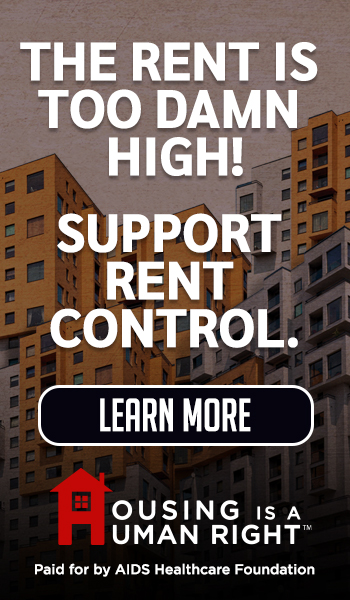Comments
PERSPECTIVE - In previous columns, I have written about the concentration of Executive Directive 1 units in Westchester. All of the units in Westchester are in an Airport Hazard Zone, most are within the noise contour of LAX, and all are within areas of significantly elevated levels of ultra fine particulate matter, which is damaging to human health.
Councilwoman Traci Park’s staff has reported that she will file a motion to request an airport impact exemption from the Executive Directive 1 permanent ordinance. We appreciate that because Executive Directive 1 is supposed to help people--not harm them. In previous columns, I have shared the research showing the harm to people living so close to LAX. Housing people of low income in projects where they will suffer harm is contrary to the purpose of ED 1. Developers would still be able to build projects, but not without meeting all requirements applicable to projects that are not streamlined by ED 1.
Official numbers recently reported in official documents show a disturbing trend in CD 11 of Executive Directive 1 units particularly close to LAX, while the most other communities in CD 11 remain free of a single project. Moreover, recently released official numbers show yet another disturbing trend of beds and safe parking for the unhoused being concentrated in certain communities of CD 11, and particularly Westchester, while most other communities in CD 11 remain free or relatively free of these interventions. Most of these interventions are in polluted areas close to LAX. It appears a containment zone for people of low income and people who are unhoused is developing in Westchester, while the whiter and more affluent communities with less pollution in the council district remain free of these interventions.
Official count of the number of ED 1 units in the pipeline in CD 11
Westchester has more ED 1 units in the pipeline than all other CD 11 communities combined, according to the ED 1 table maintained by the city.
We are seeing geographic concentration, rather than geographic distribution, of ED 1 projects in CD 11. Most of the ED 1 units in the pipeline in Westchester are very close to LAX, most are in the noise contour, and many are under the landing path used by jets in this approach to LAX.
The ED 1 table shows the number of units by CD 11 community plan area as follows:
|
ED 1 projects in CD 11 |
|
|
Westchester |
1088 |
|
West LA/Sawtelle |
466 |
|
Del Rey |
201 |
|
Mar Vista |
118 |
|
Palms |
0 |
|
Venice |
0 |
|
Palisades |
0 |
|
Brentwood |
0 |
|
Playa del Rey |
0 |
|
Playa Vista |
0 |
Source: ED 1 case summary, which can be found on this page
Official count of the number of homeless housed by community in CD 11
For several years, the City of Los Angeles has been working toward providing a sufficient number of beds for at least 60 percent of the unhoused, pursuant to the Alliance settlement agreement.
The numbers regarding the number of homeless housed in CD 11 are concerning. The 2025 LAHSA point in time count shows that Westchester, in this category also, has more homeless beds than all other communities in the council district combined, as follows:
|
2025 PIT count |
Sheltered persons in shelter |
|
Venice |
19 |
|
Mar Vista |
15 |
|
Del Rey |
0 |
|
West LA/Sawtelle |
0 |
|
Brentwood |
0 |
|
Palisades |
0 |
|
Westchester/PDR/Playa Vista |
57 |
|
Palms |
0 |
|
Total for CD 11 |
91 |
Source: LAHSA 2025 Greater Los Angeles Homeless Count by locality, available as a dashboard on LAHSA’s website.
In addition, Westchester has 159 more homeless beds on the way. The Extended Stay Homekey at 6531 Sepulveda in Westchester, which has been fully approved and funded, will open soon, and that project has 119 suites for individuals who are unhoused. The Red Tail Crossing project at 8333 Airport Avenue (also near LAX) has been built and will open soon with 40 permanent supportive housing units for the unhoused.
There is a 600-bed facility for providing permanent supportive housing for veterans on Arbor Vitae and Hindry, very close to LAX. While this project is technically within the boundaries of another incorporated city adjacent to Westchester, it is right across the street from Westchester. This project is in the noise contour and under the flight approach path to LAX. Ironically, there are far more beds for veterans in this facility than there are at the veterans’ facility located on federal land between Westwood and Brentwood, which is a much nicer area for veterans. The photo with this column shows is a photo of the veterans’ housing near LAX, with bars on the first-floor windows and a jet coming in for landing overhead.
In July, plans were announced to convert the Sheraton Four Points at 9750 Airport Boulevard near LAX to “affordable housing.” This project has 579 units formerly used as hotel rooms. The project shares a boundary with LAX on two sides, and the project is between the north and south runway jet landing approaches. It is in a noise contour with even higher and more dangerous levels of noise.
While the numbers increase and result in a large concentration of units in Westchester, there is a Ramada Inn Homekey in Venice, which is no longer open, and it is not on the CAO list of interventions filed with the federal court on April 15, 2025, as an update for Judge David O. Carter in the Alliance v. City of LA case. A Bridge Home in Venice that sheltered over 150 unhoused people has been permanently shut down, and the Venice-Dell affordable housing project with a number of permanent supportive housing units is tied up in litigation. From 2024 to 2025, the number of unhoused people sheltered in Venice, according to the LAHSA PIT counts, decreased from 239 to 19. The information for number of people sheltered by community for 2024 is available on this LAHSA dashboard. This is reverse progress.
Safe Parking Interventions in CD 11
As for safe parking, there are 50 spaces in Westchester and another 50 spaces in West LA. The other CD 11 communities have none.
|
Safe Parking spaces in CD 11 |
|
|
Westchester |
50 |
|
West LA Sawtelle |
50 |
Source: CAO document filed in federal court in Alliance case on 4/15/25 showing sheltering plans by council district
What this means—well, the numbers say it all
The official numbers show a troubling trend of units for the unhoused and people of low income being concentrated in Westchester and a couple other communities in CD 11. The areas south of Lincoln and west of San Vicente have no ED 1 projects or no safe parking, and most of them have no homeless beds. Recently, a “Westside Renaissance” was declared for CD 11, but it seems to apply only to the whitest and most affluent communities in the district. It appears that a two-tier council district is in the making.
While there seems to be an unwillingness to provide homeless interventions or affordable housing in many areas of CD 11, our coastal neighbors on either side of Venice, including Santa Monica and Marina Del Rey, have affordable housing/homeless beds to address the need in their communities.
Santa Monica is complying with AFFH and is taking responsibility for the history of excluding people of color. Santa Monica is also taking responsibility for the homeless that are attracted to the coast by providing homeless beds, and it is providing affordable housing in order to address the exclusion of people of color in the past. Santa Monica is a community with many tourists, and the affordable housing will undoubtedly serve the workers in the tourist industry. Marina del Rey is taking responsibility by providing affordable housing with an affordable housing project recently announced. Both of these areas are within the coastal zone.
Affirmatively furthering fair housing
This concentration of interventions in a few communities while having none in other communities of the council district is concerning in light of state and federal principles “affirmatively furthering fair housing.” AFFH is defined by the state as:
"Meaningful actions, in addition to combating discrimination, that overcome patterns of segregation and foster inclusive communities free from barriers that restrict access to opportunity based on protected characteristics. Specifically, affirmatively furthering fair housing means taking meaningful actions that, taken together, address significant disparities in housing needs and in access to opportunity, replacing segregated living patterns with truly integrated and balanced living patterns, transforming racially and ethnically concentrated areas of poverty into areas of opportunity, and fostering and maintaining compliance with civil rights and fair housing laws. The duty to affirmatively further fair housing extends to all of a public agency’s activities and programs relating to housing and community development."
State law expanded and protects the duty to affirmatively further fair housing in California
AB 686, effective January 1, 2019, expanded and protects the duty to affirmatively further fair housing in California. According to the National Housing Law Project, AB 686 Introduces an AFFH obligation into state law:
- Defines “affirmatively furthering fair housing” to mean taking meaningful actions that “overcome patterns of segregation and foster inclusive communities free from barriers that restrict access to opportunity” for communities of color, persons with disabilities, and others protected by California law
- Requires the state, cities, counties, and public housing authorities to administer their programs and activities related to housing and community development in a way that affirmatively furthers fair housing
- Prohibits the state, cities, counties, and public housing authorities from taking actions materially inconsistent with their AFFH obligation
- Requires that the AFFH obligation be interpreted consistent with HUD’s 2015 regulation, regardless of federal action regarding the regulation
- Adds an AFFH analysis to the Housing Element (an existing planning process that California cities and counties must complete) for plans that are due beginning in 2021
- Includes in the Housing Element’s AFFH analysis a required examination of issues such as segregation and resident displacement, as well as the required identification of fair housing goals
The Alliance settlement agreement and Mayor Bass’s third revision to ED 1 both speak to geographic distribution
Creating a containment zone in Westchester for people who are unhoused and of low income would violate both the intent of the settlement agreement in the Alliance v. City of Los Angeles case.
Consistent with this, Mayor Bass emphasized in her third revision to ED 1 that geographic distribution of projects is expected. In that revision, Mayor Bass stated that it is important that we include regulations to promote geographic equity and the distribution of affordable housing citywide.
Environmental justice
The City of LA is bound by state law on environmental justice and is committed to ensuring environmental justice, as described here. According to this city website, “[t]he principle of environmental justice ensures equal and equitable protection from environmental and health hazards.”
Councilwoman Park spoke in support of environmental justice laws, and was quoted here during her campaign, as saying: “[E]nvironmental justice issues are finally being centered in the city’s decision-making process. For too long, low-income communities have (literally) been the dumping ground for dirty polluters and unhealthy developments.”
Plaintiff’s attorneys refer to these “dumping grounds for dirty polluters and unhealthy developments” as “sacrifice zones” and “death zones.”
Where things stand now for housing and interventions in CD 11
CD 11 needs more affordable housing, and homeless housing is a type of affordable housing. CD 11 is undoubtedly looking to have enough homeless beds so that it can begin enforcement under the Alliance settlement agreement. For years, we have heard the NIMBY chorus from one CD 11 community in particular of “move them to the desert,” “move them somewhere less expensive and less desirable,” “move them to LAX,” “move them to the Palisades,” and “move them to Westchester.” There are a number of published articles and letters to the editor suggesting this.
Looks like it is happening, and at the cost of people’s health and for some, their lives. The area surrounding LAX is certainly "less expensive and less desirable" because it is not safe for full-time human habitation. This is why more than 4,000 Westchester and Playa del Rey homes were taken by eminent domain as the size of jets, the pollution, and the number of LAX flights increased and a runway was added. However, concentrating formerly unhoused and people of low income in this area is inconsistent with AFFH, the Alliance settlement agreement, and the purpose of ED 1, and many would say it's cruel and unethical. There’s no way to stop this environmental pollution, short of jets becoming electric, which won’t happen anytime soon.
An airport exemption from ED 1 is essential to protect the health and safety of people who would live there in projects, some of which have hundreds of units, among the heavy LAX traffic, no green space, high levels of air and noise pollution, no onsite parking, and the aging infrastructure of Westchester Playa. Developers could still request permits to build housing in these areas, but with the ED 1 exemption from the permanent ordinance, a developer would not get “streamlined” approvals, bypassing important protections. We await the prompt filing of that motion.
In addition, we look forward to seeing a more equitable distribution of ED 1 units, homeless beds, and safe parking among communities in CD 11, consistent with AFFH, the Alliance settlement agreement, and the mayor’s intention of geographic distribution of ED 1 projects.
(Rosa Padilla is a retired trial attorney and lifelong Los Angeles resident who has been a vocal advocate for her Westchester community, challenging city upzoning plans that threaten local neighborhoods with overdevelopment and environmental risks.)






